Read the article at your own risk. |
| Lara Croft | ||
|---|---|---|
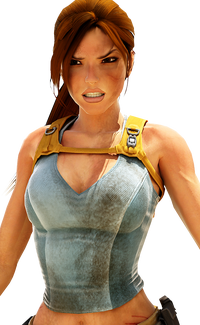 Lara Croft, as she appears in a promotional render from Tomb Raider: Anniversary |
| |
| Date of birth: | First Timeline February 14, 1968 Wimbledon, London Third Timeline (Age:21)1991 or 1992 | |
| Blood type: | AB- | |
| Gender: | Female | |
| Height: | First Timeline 1.80 m Second Timeline 5ft 9inch / 1.75 m Third Timeline 5ft 6[1] / 1.68 m | |
| Weight: | 131lb / 59.7 kilo | |
| Favourite Weapon: | 9-mm Twin Colt 45s | |
| Nationality: | British | |
| Profession(s): | Archaeologist, Adventuress | |
| Status: | Alive | |
| Family: | First Timeline Angeline Lodge-Croft (mother) Henshingly Croft (father) Second Timeline Amelia Croft (mother) Richard Croft (father) Richard J. Croft (grandfather) | |
| Appearances: | All Tomb Raider related products | |
| Voice: | Shelley Blond (1996) Judith Gibbins (1997–1998) | |
| Portrayer: | Angelina Jolie (films) | |
Lara Croft is the main protagonist and heroine of the Tomb Raider franchise. She is presented as a beautiful, intelligent, and athletic English archaeologist-adventuress who ventures into ancient, hazardous tombs and ruins around the world. Created by a team at UK developer Core Design that included Toby Gard, the character first appeared in the 1996 video game Tomb Raider.
Story[]
First Timeline[]
Lara Croft, daughter of Lord Henshingly Croft , was born in England on February 14th 1968. She was raised to be an aristocrat from birth, and had lived in luxury aloof from the world at large. From the age of 3 Lara began her learning with a private tutor. Lara attended Wimbledon High School for girls at the age of 11.
At 16 her parents decided she should broaden her education by studying at Gordonstoun, one of Britain's most prominent boarding schools. One day Lara came across a copy of National Geographic on the hall table. The front cover featured a familiar name, the Professor Werner Von Croy. A respected archaeologist, Von Croy had once lectured at Lara's school to pupils & parents alike. The experience had a profound effect on Lara, triggering a desire for travel to remote locations in search of adventure. In some ways Von Croy had become an inspirational figure for Lara. As Lara read further, she learned that Von Croy was currently preparing for an archaeological tour across Asia, culminating in a potential new discovery to be made in Cambodia. Unable to pass up this opportunity, Lara burst into the room, thrust the article in front of her parents & without hesitation demanded she accompany Von Croy on his expedition.
Lord Croft could hardly disagree that travel was an education in itself. As Lara argued the case further, he found himself walking over to the desk & penning a letter to Von Croy. He Introduced himself as an influential society figure and offered financial assistance in exchange for his daughter's place on the expedition. Von Croy's reply assured the Henshingly Croft's that the territories were friendly and that he had ample experience to look after both his & Lara's well being. Lara's company as an assistant would be welcome, as was the offer of such a generous cheque. He remembered Lara from his lecture - her incessant yet insightful questions had made quite an impression upon him. And so it was agreed by all that Lara would accompany Von Croy for the duration of the tour.
Lara should have died there, as most people would have, instead she learned how to depend on her wits to stay alive in hostile conditions a world away from her sheltered upbringing. Two weeks later when she walked into the village of Tokakeriby her experiences had had a profound effect on her and in that process transformed herself as well. Her Himalayan odyssey was both miraculous and enlightening, as the young woman not only survived, but gained a perspective on herself and the world that made her past appear shallow and naive. Out of the darkness of her ordeal, she saw her future reflected in a different light.
She felt profoundly that there was more for her in this life than the coddled existence that had become her numbing habit. She realized that she was only truly alive when she was travelling alone. Over the eight following years she acquired an intimate knowledge of ancient civilizations across the globe. Her family soon disowned their prodigal daughter, hoping she would wed The Earl of Farrington. She turned to writing to fund her trips.
Famed for discovering several ancient sites of profound archaeological interest and gaining some notoriety for having slain an actual Bigfoot in North America, she made a name for herself by publishing travel books & detailed journals of her exploits. Lara Croft became the seeker of truths, both large and small, and in that pursuit she continues to this day.
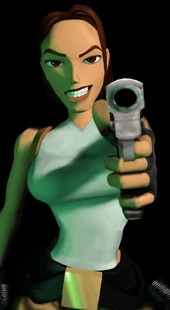
In 1996, Lara is contacted by an American named Larson Conway, who works for the wealthy businesswoman Jacqueline Natla, owner of Natla Technologies . Natla ask her to go on an expedition to recover a mysterious artifact called the Scion from the lost tomb of Qualopec , in the mountains of Peru, Lara first refused, but accepted after Natla told her the path of the expedition to access the tomb, thinking it would be a great adventure. After successfully retrieving the object, she is attacked by Larson who attempts to claim it. She beats him then questions him, learning that the artifact she has is only a fragment and that a man named Pierre Dupont has been hired by Natla to collect the rest.
Lara breaks into Natla Technologies to find out Pierre's whereabouts. She discovers a medieval monk's journal, which reveals the depths of an ancient monastery of St. Francis in Greece to house the tomb of Tihocan , a ruler of Atlantis, along with a second piece of the Scion. Travelling to the monastery, Lara descends through an expansive underground complex, pursued and attacked throughout by Pierre Dupont. At the tomb of Tihocan, Lara recovers the second piece of the Scion and finally kills Pierre. An inscription inside the tomb states that Tihocan was "one of the two just rulers" of Atlantis.
When Lara joins the two pieces of the Scion, she receives a vision of the three Atlantean rulers and their respective pieces of the Scion. One of them utilises it to create a mutant breed, but the other two confront her, and take her piece of the Scion. Then Atlantis is struck by a fireball from the skies, and the three pieces of the Scion become scattered as the civilisation is destroyed. One of them goes to Egypt, Lara's next destination.
Lara travels to the City of Khamoon, a temple complex in Egypt that houses the final fragment. Here she battles the fierce mutants seen in her vision, and is once again confronted by Larson, this time in a battle to the death. She then takes the final piece of the Scion from the underground sanctuary. Upon leaving the tomb, she is ambushed by Natla and her henchmen, who steal the three artifacts and nearly kill her.
Having escaped, Lara sneaks onto their boat, which takes her to a remote island where mining operations of Natla Technologies have partially exposed the Great Pyramid of Atlantis . After making her way through the mines dispatching Natla's goons and the mutant-infested interior of Atlantis, she crosses the way of a mutant skinless strangely look like her and copying all of her movements, although this doppelganger was not a threat at this time, Lara get rid of it. Lara finaly reaches the heart of the pyramid chamber, where the complete Scion has been fused together as a source of power. Touching it, Lara receives another vision, where Natla is revealed as the previously seen third ruler of Atlantis. She betrays her co-rulers by abusing the power of the Scion for genetic experimentation, and as punishment is locked in a stasis cell by Qualopec and Tihocan, her resting place until the prologue of the game.
Natla enters the chamber and confronts Lara; having reclaimed the artifacts, she attempts to restore her former power with an army of mutants. Lara throws her into a chasm, apparently killing her and confronts her newest mutant abomination. She then destroys the Scion, starting a chain reaction of collapse in the pyramid. As she makes her way out she meets Natla a final time, now mutated and winged. After beating her, Lara flees the island just as the place is destroyed.
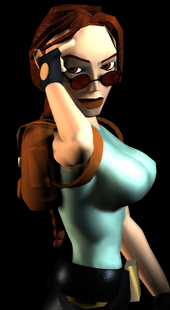
A year later, when Lara investigates the legend of the Dagger Of Xian, she is attacked by a thug who claims to work fora man named Marco Bartoli, a Venetian Mafia leader who has an obsession with the ancient lore of the Dagger. After traveling to Venice, Lara makes her way through Bartoli's hideout and an opera house where Bartoli's men are plotting a heist. Lara manages to follow Bartoli aboard his aeroplane, but she is knocked unconscious before she can confront him.
The plane is headed toward an oil platform. At the site, the cult of Xian have killed all the rig's staff, dumping the bodies into the sea and are carrying out excavations on a sunken ship called the Maria Doria , a luxury ocean liner which was owned by Marco's Father that sank two years ago. When Lara regains consciousness, she learns that the crew have taken her weapons and equipment. She retrieves her weapons and makes her way through the oil rig. She later learns from an imprisoned Tibetan monk, Brother Chan , that the shipwreck carries an ancient Tibetan artifact called the Seraph . Lara dives alongside a submersible and arrives at the shipwreck. There she successfully retrieves the Seraph. Having obtained this, she heads towards the monastery via aeroplane.
As Lara heads to the Tibetan monastery the plane suffers engine failure and crash lands. As the plane is skidding along the ground she manages to escape using a parachute and arrives at the Barkhang Monastery in Tibet. There she is helped by monks in confronting the thugs of Marco Bartoli. With the help of the monks, she finds and uses five prayer wheels to open a door that leads to a room to hold the Seraph. She continues her journey inside the catacombs to find the Talion , a key used to open the door which leads to the dagger. After confronting several yetis, she recovers the Talion. The FMV cutscene shows Lara exiting the caves. She takes off in a jeep while a guard is patrolling outside. Another jeep with two guards follows Lara, but she manages to escape.
Back in China, Lara opens the door to the chamber holding the Dagger. Before she reaches the artifact, however, Lara is plunged into the catacombs beneath the Great Wall. After climbing a staircase with blades, she makes her way to a place with green floating islands and warriors which come alive when triggered. She finally moves to the room where she witnesses Bartoli drive the dagger into his heart, transforming himself into a dragon. Lara manages to temporarily render the creature unconscious and pulls the dagger from Bartoli's heart. Soon after this, the whole tomb begins to collapse, and a part of Great Wall is destroyed. Lara returns home and is cleaning the dagger when she hears an alarm going off. She discovers the remainder of Marco Bartoli's men have tracked her down to England and are planning to invade her mansion. Luckily she overpowers them.
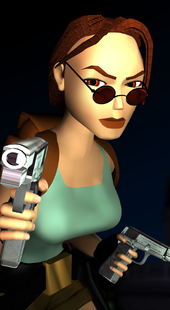
In 1998, Lara Croft is searching for an artifact in the ruins of an ancient Indian temple once inhabited by the Infada tribe. She encounters a researcher working for RX Tech who appears to be insane. After parting ways, the researcher beats Lara to the Infada Stone, gaining supernatural powers. After killing him and taking the artifact, Lara is approached by Dr. Willard , the head of RX Tech, who explains the origins of the Infada Stone. Thousands of years ago, Polynesians came across the meteoroid crater and found that it had incredible power. Using rock from the meteoroid, they crafted four crystalline artifacts, one of which is the Infada Stone. They then fled Antarctica for unknown reasons, but, in the nineteenth century, a group of sailors travelling with Charles Darwin came to Antarctica and discovered the artifacts. The four stones were then distributed across the globe. Dr. Willard has been able to track the artifacts by using the diary of one of the sailors. Lara agrees to help find the other three stones.
In London, Lara searches for the Eye of Isis, now in the possession of Sophia Leigh, the head of a cosmetics corporation. Lara learns that the corporation has performed sick experiments on humans in order to achieve immortality and eternal youth for Sophia's personal gain. The deformed subjects of Sophia's failed experiments, presumed dead by the corporation, were dumped in the sewers, and assist Lara in exchange for a bottle of embalming fluid from the Natural History Museum. Sophia sends a number of assassins, under her employment, to kill Lara. However, they are all unsuccessful and Lara climbs through a ventilation shaft to Sophia's office where she is sitting with the artifact on her desk. Sophia mockingly offers Lara a job, telling her that with her lifestyle she would be the perfect face for her products, then Lara tells Sophia that her human subjects she experimented on are still alive. Lara demands she hand over the artifact which she refuses to do. Sophia takes the artifact and runs out the balcony to the other building and Lara who works her way up Sophia's building and across to the one she is on. Sophia attempts to kill her using the powers of the artifact, but Lara defeats her by shooting a fuse box connected to an electrical bridge that Sophia was standing on after the battle causing her to get electrocuted.
On an island in the South Pacific, Lara fights cannibal tribesman, Velociraptors, a T-Rex and encounters a wounded soldier who tells her of a deity who lives in the hills of the island. Lara pursues the deity and learns from one of the tribesman that one of Darwin's sailors brought one of the artifacts to the island from Antarctica. She also learns about why the inhabitants fled their city there; the son of the leader was born without a face, caused by prolonged exposure to the Meteorite. Lara then infiltrates the deity's temple and the deity Puna, who has immense power granted by the meteor artifact called the Ora Dagger.
Arriving in Nevada and making her way through a desert canyon, Lara tries to enter Area 51, where Element 115, one of the four artifacts, is located in an alien spacecraft guarded by the government. But she faces a severe setback when she is taken as a prisoner in the base after her attempted break-in ends disastrously. Freeing herself and the other inmates, she escapes the security compound and stows away in a truck to Area 51.
Angered, she meets and confronts Dr. Willard, who reveals that he is planning to encourage these mutations on a global scale, using the combined power of the Artifacts and the Meteorite they were carved from. As Lara voices her opposition to his operation, Willard betrays her, stealing the artifacts and disappearing into the excavation site. After fighting more mutants (including insectile and reptilian things within the city itself) and navigating the treacherous ruins of the ancient city built atop the meteor crater, Lara faces Willard, who has now used the power of the four artifacts to activate the even greater power of the meteor: to greatly speed up the evolutionary processes of the human body and thereby turning himself into a terrifying and all-powerful Spider-like creature. Lara deactivates the meteor by taking the artifacts out of their positions that they were put in, kills the mutated Spider Willard and escapes by helicopter.
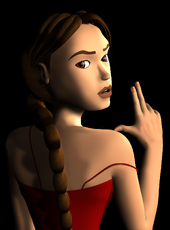
In 1999, Lara and a local guide are searching for the Tomb of Seth, hoping to find the Amulet of Horus, a charm in the shape of an ankh, set with a ruby. Upon removing it from a sarcophagus, she finds that the amulet is the key to sealing the dark god Set away for eternity. Horus and his ally Semerkhet constructed the sarcophagus to hold Set and that, by removing the amulet, Set has been released. Her guide is revealed to be working for Von Croy, who is determined to take the amulet for himself. Lara quickly escapes after being chased by Von Croy's mercenaries.
Lara visits an old friend, Jean-Yves, who reveals to her the full magnitude of her mistake. He also reveals that the one place where she might find a way of reversing the damage is in the Tomb of Semerkhet, hidden in the ruins of Karnak. Lara goes there and, after fighting off Von Croy’s mercenaries, finds the entrance and opens it with the amulet. Von Croy follows her, steals the amulet and seals Lara inside. After negotiating various traps and strange enemies within the tomb itself, she finds inscriptions put there in case Set was ever released. It tells of the Armour of Horus, used by the god in his battle with Set. When an ancient astrological conjunction occurs (called the Millennial Constellation), and the armour, together with the amulet, is placed on Horus’s statue within his temple under the Great Pyramid of Giza, the god can be summoned and imprison Set once again.
After escaping a monster in the Tomb (resulting in her guide being killed) and jumping aboard a train, she makes her way to Alexandria, where she once again meets Jean-Yvre. He tells her that his excavations around Cleopatra’s palaces have been interrupted by strange creatures frightening the workers away. Lara goes through the palaces and eventually gains the armour. But, on returning to Jean-Yvre, she finds that he has been kidnapped by Von Croy, with the price of his release being the armour.
Lara travels to a rendezvous in Cairo to find the city in chaos and the sky darkened by strange clouds. After battling her way through the streets, she finds a wounded Egyptian sergeant, who tells her of strange and diabolical creatures who have arisen and are now guarding the ancient sites throughout the city. After carrying out several tasks for the sergeant, he drives a truck full of explosives into a massive, dragon-like creature guarding the way to an ancient citadel, giving his life so that Lara can continue. Lara finds Jean-Yvre, who reveals that Von Croy has been possessed by Set and is digging in ancient crusader vaults for the Ceremonial Tablet, which contains Set’s binding spell. Lara, after traversing the citadel and avoiding resurrected crusader knights, finds Von Croy/Set in an old tomb opened with the Amulet. Set offers to ‘grant [her] vigour as those around [her] fall’. Lara refuses and runs out of the tomb, pulling the Amulet away, trapping Von Croy/Set inside.
Lara finally travels to Giza, where the forces of Set have gathered to block the way to Horus, since the Millennial Constellation is in position. Lara, after fighting her way through those forces and climbing the Great Pyramid, finds her way down into the Temple of Horus and, fitting the armour and amulet to the statue, summons Horus. Horus partially completes his transfer, but Set arrives and destroys the armour, though the amulet remains undamaged. Lara makes her way out, avoiding Set’s attacks until in the safe light of the constellation. Then she locks the doors into the temple with the amulet, trapping Set inside forever. Making her way out completely exhausted, Lara sees Von Croy at the entrance. Unsure about whether he is free of Set’s influence, she is unwilling to take his arm as the temple begins to collapse around her. Von Croy tries to save her as she hangs from a ledge, but is forced to rush out, leaving Lara presumed dead.
A memorial service is held, soon after which Winston Smith and Father Patrick Dunstan reveal that Werner von Croy is excavating the dilapidated temple in the hope of discovering her alive.
Later in Egypt, Werner von Croy is excavating the collapsed temple. A young boy gets the attention of Werner and asks him to come and see. He follows. When he enters the tomb, he demands to see what they have found. It is Lara's backpack. He then declares: "We've found her!", presuming that Lara is alive.
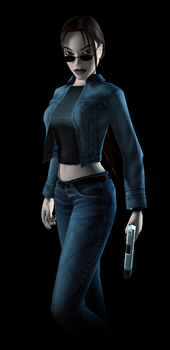
Lara Croft receives a message from her former mentor and friend, Werner Von Croy. Going to Paris and finding in his apartment, Von Croy tells her that he is tracking five mysterious Obscura Paintings for a client named Pieter van Eckhardt . But Von Croy has learned that Eckhardt is a psychopath who plans to use the paintings for evil purposes. Lara angrily refuses to help him, Werner pulls a gun and a fight ensues, with Lara being knocked unconscious. When she recovers, she finds Von Croy dead, seemingly killed by the Monstrum, a notorious serial killer who has been terrorizing Paris. Forced to go on the run from the police and sneak through Paris, she finds Margot Cavier , a friend and colleague of Von Croy. Though suspicious of Lara, Cavier gives her Von Croy’s journal. Lara finds out that Von Croy had located the fourth Painting under the Louvre and had contacted a local gang leader called Louis Bouchard for the necessary equipment. Lara finds Bouchard and he allows her to take the equipment herself from one of his agents, Daniel Rennes. But, when she goes to the shop where Rennes works, she encounters a man who she later remembers to have been Von Croy’s attacker. She also finds that Rennes is dead, killed by the Monstrum. When she recovers all the equipment, she sets off a bomb, but is able to escape in time.
Second Timeline[]
Lara Croft was born in Surrey's Parkside hospital to Lady Amelia Croft and the notorious archeologist Lord Richard Croft, the late Earl of Abbingdon. Between the ages of three and six, she attended the Abbingdon Girls School, where it quickly became clear that she was an exceptionally gifted child. At the age of nine she
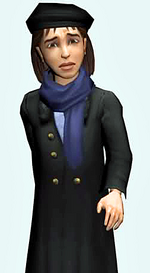
Lara as a child
survived a plane crash in the Himalayas that took the life of her mother. In perhaps the first story of her prodigious indomitability, she somehow survived a solo ten-day trek across the Himalayan mountains, one of the most hostile environments on the planet. The story goes that when she arrived in Katmandu she went to the nearest bar and made a polite tele-phone call to her father asking if it would be convenient for him to come and pick her up.
For six years following the plane crash, Lara rarely left her father’s side, traveling around the world from one archeological dig site to another. During this period she was ostensibly given a standard education from private tutors, but it would probably be more accurate to say she was her father’s full time apprentice.
When Lara was fifteen, her father went missing in Cambodia. Extensive searches by the authori-ties and Lara herself turned up human remains that could not definitively be identified. Since Lord Croft’s body was not officially recovered, Lara could not directly inherit the Croft title and Lara was thrust into a bitter family feud over control of the Abbingdon estates with her uncle Lord Errol Croft. Lara eventually won the legal battle, and took possession of her inheritance but at the cost of a deep rift in the Croft family that left her estranged from her living relatives.
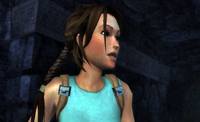
Lara as a Teenage
When Lara was a teenage, she once made an archaeological excavation with her university colleagues, where she and Amanda Evert witnessed an unknown demonic entity kill the rest of the team. Lara and Amanda ran from the unknown monstrous being before being trapped in a large room. The monster was about to kill Lara when Amanda pulled a glowing stone, later known as the Wraith Stone from the wall, causing the creature to disappear into it. However, the room started to flood, causing several gates to close at the same time and as they tried to escape, Amanda's shoe got trapped under a pile of rubble. Even though Lara tried to keep one of the gates from closing, Amanda was seemingly buried alive by falling rubble. Lara still held on to the door until she ran out of air, swimming away impotently after her failure to save Amanda from her death.
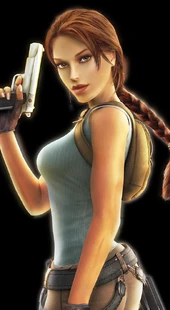
In Calcutta 1996, Lara Croft is approached by Larson Conway, who introduces her to Jacqueline Natla, who wishes Lara to find a piece of an artifact called the Scion, located in the Peruvian mountains. Lara, having searched unsuccessfully for such an artifact with her father in the past, agrees to go. In the Peruvian mountains, Lara finds a tomb belonging to the Atlantean king Qualopec. She discovers that he was one of three God-Kings (the Triumvirate) who ruled Atlantis before it sank. Lara leaves with a piece of the three-part Scion, but notices movement from what had appeared to be a statue of Qualopec before the tomb collapses. Shortly after, Lara is confronted by Larson, who attempts to take the Scion piece from her. After knocking him out, she discovers that Natla has sent Pierre Dupont, another archaeologist, to find the next piece. Lara breaks into Natla's office and finds evidence that the next piece of the Scion is located in St. Francis Folly in Greece.
Lara departs to Greece, and finds the second piece of the Scion in the depths of a tomb. While Lara studies the empty coffin of Tihocan , the second member of the Triumvirate, Pierre ambushes Lara, forcing her at gun point to give up her piece of the Scion. After Pierre takes the piece Lara tries to take him by surprise but he escapes with the Scion piece in hand, only to be killed by guardian centaurs outside of the tomb. After defeating the centaurs, and joining both pieces of the Scion, Lara sees a vision,and it reveals the location of the third and final piece of the Scion: Egypt.
Lara travels to Egypt, and successfully retrieves the third piece of the Scion. After assembling all three pieces, Lara's earlier vision becomes much clearer.In Lara's visions Two of the three Kings, Tihocan and Qualopec, are sentencing the third one, revealed to be Natla, to imprisonment. Natla, after releasing Atlantis' own army against itself in an attempt to bring about what she refers to as the Seventh Age, is imprisoned in the crystalline structure for a thousand years.
With Lara in a trance, Natla steals the Scion, and has Lara restrained by her three henchmen. Lara escapes and follows the departing Natla on a motorbike, managing to sneak onto Natla's departing boat. Lara follows Natla into a desolate mine, and kills Larson when he tries to stop her. Visibly shaken, Lara then confronts Kold and Kid, who end up killing each other in the skirmish. Lara then travels to the top of the Atlantean pyramid and confronts Natla.
Not long into the confrontation with Natla, Lara realises that Natla's plan is to resurrect the army of Atlantis. Natla attempts to convince Lara to stop opposing her, and become immortal like her. Lara destroys Scion instead, and is then tackled by Natla, who falls into the lava while Lara uses her grappling hook to survive. Lara, thinking Natla dead, tries to escape, being confronted by a giant mutant along the way. She is soon confronted by an angry Natla, severely burnt, but unimpeded in ability. After a confrontation, Lara collapses a pillar supporting the pyramid onto Natla, trapping her under the collapsing pyramid. Lara escapes and sails away in Natla's boat.
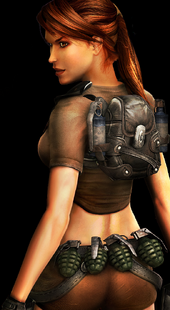
Years later, Lara travels to the cliffs of Bolivia to find a similar stone dais located in the ruins of Tiwanaku, a pre-Incan civilisation. After some ordeals, she runs into a group of mercenaries who are under orders to kill her on sight. She disposes of them and proceeds to a temple encountering more mercenaries and dangerous native wildlife along the way. On the other side of the temple, she sees the dais mentioned in the call from Anaya and finds James Rutland, a rich American socialite and self-proclaimed adventurer. Rutland, holding an unusual sword fragment, mentions Amanda, the friend of Lara's who died years before in an excavation that turned into a tragedy. He then orders his mercenaries to kill Lara. She overcomes them and reaches the dais, confirming that it was the same design as the Himalayan one. When Lara returns to her mansion, she asks her friend and computer specialist, Zip to find out where Rutland will be going next.
Lara meets Anaya in a village in Peru, and after yet another battle with Rutland's mercenaries, and a motorcycle chase, they reach the tomb in Paraíso, where the tragedy befell them years ago. Lara goes down into the caves of the excavation site, the site that contains the tomb of the Queen of Tiwanaku and discovers the artifact she is seeking may be linked to Excalibur , part of the King Arthur legends, and that Amanda may have survived the cave-in and is looking for the sword, which reportedly had been broken into four fragments that are now spread across the globe. Lara, now knowing what she is looking for, recalls that one piece is in the 'care' of Yakuza boss Shogo Takamoto, who had it stolen from Waseda University. Lara escapes the excavation site and successfully kills some invading mercenaries.
When Lara arrives in Japan, she meets her friend in the Japanese media, Toru Nishimura at a party he is hosting. Lara plans to meet Takamoto to negotiate for his sword fragment. When Lara comes out of Nishimura's office, she finds the party guests scrambling to the elevator, and Takamoto's heavily tattooed Yakuza henchmen gesturing for them to go upstairs. Lara starts talking to Takamoto. Takamoto refuses to negotiate, claims he has no idea what she is talking about, and orders his goons to kill Lara. Lara disposes of the goons and chases Takamoto across the rooftops of Tokyo all the way to the roof of his penthouse apartment. Takamoto uses the power of the fragment to attack Lara but she kills him and recovers it. Lara is then picked up in a helicopter by Nishimura, who says Zip has found Rutland, deep in the Ghana rain forest.
Lara proceeds to Ghana and follows a path to a temple site her parents worked on before she was born, where she finds Rutland again, who is also in possession of a sword fragment. She follows him into an ancient temple hidden behind a waterfall. Halfway through the temple, Lara finds a locket. She remembers that her father had bought a new one for her mother because of a locket she lost. The inscription on the locket reveals it to be her mother's. When she reaches Rutland, he mentions an artifact called the Ghalali Key, believing that Lara's father found it and it is now in Lara's possession. Lara appears to have no knowledge of the key and this frustrates him. Rutland then attacks her using his sword fragment but Lara subdues him and grabs the second fragment. She then receives news from Zip and Alister that Amanda raided Croft Manor looking for the Ghalali Key only moments ago; that explains why she was unable to reach them during her climb. She offers to return to the Manor to see if they are alright, but they persuade her to try to beat Amanda to an abandoned lab in Kazakhstan, the apparent location of the third fragment.
When Lara parachutes into Kazakhstan, she finds soldiers struggling against Rutland's men. After she helps them, two soldiers tell her that their command centre has maps that might help her get to the lab. When Lara arrives there, she finds satellite maps that show a train runs past the lab. Lara hurries to the train station, only to find the train leaving, with Amanda's mercenaries aboard. She jumps on a motorcycle, prepared to follow the train. She succeeds, but the train catches fire and explodes in the lab, making her the only survivor. But Amanda is already safe inside. After she has turned on the power from the lab's generator room, she discovers that Rutland's men have taken over the Soviet Union laboratory where experiments on a sword fragment were conducted by the KGB fifty years ago. But the experiment turned into tragedy with an unknown cause. Lara catches up with Amanda, who is still bitter about being left to die in Paraíso. Lara goes after her and finds her conducting experiments on the third sword fragment. Amanda is also using the glowing stone she pulled out of the wall in Paraíso to control the unknown entity that attacked them. Lara avoids the entity since she cannot defeat it yet, while she recovers the third sword fragment, and an eleventh century knight's shield which will supposedly lead her to the next sword fragment.
Following a map on the back of the shield (supposedly Lancelot's), Lara's search brings her home to Great Britain. She discovers the real King Arthur's tomb hidden under a tacky and now-derelict King Arthur tourist attraction in Cornwall, along with the final sword fragment. Inside the tomb, Lara discovers that after Arthur's death, four of his knights – Lancelot, Percival, Galahad and Bors – took fragments of the sword to locations around the world (inspiring the myth of the Grail Quest), while the final fragment was left with Arthur by Bedivere in the hope of resurrecting the Once and Future King. After slaying a sea serpent that lives in the subterranean lake surrounding the tomb and a group of mercenaries that have followed her, Lara returns to her home to figure out how to put the four sword fragments back together.
Lara realizes that the Ghalali Key was in fact a pendant given by her father to her mother to replace the locket that she had lost in Ghana. And her mother had it with her when their plane crashed in the Himalayas. Lara returns to the crash site in Nepal to find the Ghalali Key. After traversing high ledges to reach the ruins of the plane, she finds the key in the wreckage, then narrowly escapes as the plane topples over the edge of a cliff. Lara then proceeds, emotionally shaken, to the temple she and her mother found after the crash. She runs into Rutland's mercenaries, quickly defeats them and enters the temple, using the Ghalali Key to restore Excalibur back to its complete form. She hesitatingly tries to reactivate the dais but it merely collapses when she places the sword in the stone. Knowing where she must now go, Lara escapes the temple as it begins to collapse and departs.
Lara returns to the stone dais in Bolivia, where Amanda, Rutland and their mercenaries await. Lara uses Excalibur to kill the mercenaries and inadvertently kills Rutland as well. Amanda rushes over to him, and he dies in her arms. Lara apologises and tries to patch up the rift with Amanda, suggesting they use the sword together. Amanda angrily refuses and releases the entity again, this time merging with it to become more powerful. With the power of Excalibur, Lara defeats the Amanda-Hybrid creature, destroys the entity, and separates it from Amanda. Lara uses Excalibur on the dais to reopen the portal and discovers what happened to her mother. Lara realises that the portal spans time and she is seeing her mother moments before she disappears. Amanda gets up and shouts at Lara to pull out the sword or the dais will explode. Lara's mother hears this through the portal, pulls out the sword, and the dais explodes. Amanda berates Lara for her actions: however, Lara is unconcerned, furious at the realisation that Amanda was responsible for the apparent causality loop that claimed Lara's mother. Lara fires a hail of bullets around Amanda and places her gun to Amanda's head, threatening to kill her if she doesn't explain. Amanda states that Lara's mother isn't dead, but in Avalon, the mythical resting place of King Arthur, where Amanda herself wanted to go. She hisses that she is wasting her breath, that Lara will never understand. Lara spares Amanda's life, but settles for knocking Amanda out with her pistol, snarling that "From this moment, your every breath is a gift from me". After that, Lara hurries to find any information that may lead to Avalon.
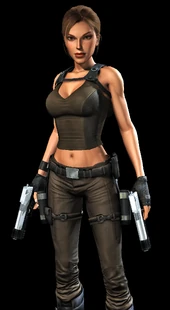
A ancient friend of Lara's father, Eddington, told Lara that her father thought Avalon could be found underneath the Mediterranean Sea, during her raid, Lara discovers an ancient temple designating itself as "Niflheim", one of the many Norse underworlds. Deep within, she recovers one of Thor's gauntlets, after a lengthily battle with Amanda Evert's mercenaries and an encounter with an imprisoned Jacqueline Natla, on Amanda's ship. Natla tells Lara that the Norse underworld, Helheim and Avalon are one and the same and that she will need to find Thor's Hammer to open the Underworld and find her mother. Lara soon discovers that she will have to find Thor's other gauntlet and his belt if she wants to find and wield the hammer. Natla provides Lara with a starting point for her search in this quest – coastal Thailand. In Thailand, Lara doesn't locate the next gauntlet, but she finds evidence that her father had found it there and removed it before he died. She also discovers a message that reveals that her father and Natla had been working together at some point and that the relationship had not ended well. Lara is able to deduce where her father hid the missing gauntlet.
Back at the Croft Manor, Lara finds her father's secret office buried beneath her home. Upon his desk, Lara discovers the gauntlet as well as a tape-recorded message, warning her that Helhiem contains a powerful weapon. Suddenly, an explosion occurs and Lara's home becomes engrossed in flames, leading back to the opening events of the game. Zip tries to shoot Lara and claims that "Lara" detonated the bomb. When Lara returns to the burning office to recover the security footage, she encounters her doppelgänger who kills Alister Fletcher. After his emotional death, Lara resolves to continue with her quest. In Mexico, Lara finds both Thor's Belt and some ancient pictographs linking the weapon in Helheim to Jormungandr, a mythical Norse sea-serpent, brought about by the seventh age. Her next stop are ruins on Jan Mayen Island that correlate to Valhalla. It is here that Lara finally recovers Thor's Hammer. In the meantime, Zip has managed to track Amanda down to a sister-ship of the one Lara sank earlier. Armed with Mjolnir, Lara boards the vessel and interrogates Natla once again. Natla provides Lara with the coordinates of Helheim, but points out that Lara does not know the Ritual of Odin, which is needed to open its gates, so Lara reluctantly strikes a bargain with Natla and frees her from her cell.
They rendezvous in the outer chambers of the Helheim complex, deep below the Arctic Sea. With the ritual performed, Lara is able to use Mjolnir to open the gates of Helheim. Along the way, Lara discovers the horrifying truth of her mother's fate – she has been turned into a thrall, where Lara forcibly shoots her. Natla reveals the true extent of her manipulation of Lara, also revealing that she was the one who killed Lara's father. Natla goes, leaving the doppelgänger to kill Lara, but Lara is saved by Amanda. It is revealed that the Midgard Serpent was a Norse metaphor for the many tectonic divisions that encircle the world, beneath the seas. The doomsday device was built upon the most unstable junction of these lines and its activation would cause massive volcanic activity across the whole planet and the destruction of most of humanity. Lara successfully destabilises the device and strikes Natla with Mjolnir, sending her down into the pool of deadly eitr below. Lara and Amanda escape together using the dais, like the one that brought Lara's mother to Helheim, teleporting back to the temple in Nepal
Third Timeline[]
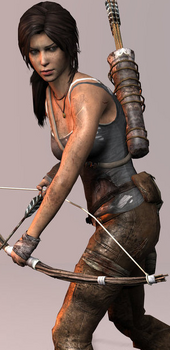
Lara Croft is a British archaeologist. She was 21 years old when she travelled for her first expedition on a ship called The Endurance with the intention of finding the lost kingdom of Yamatai. By her suggestion and against Dr. James Whitman advice, the expedition ventures into the Dragon's Triangle, east of Japan. The ship is struck by a violent storm and split in two, leaving the survivors stranded on an isolated island. Lara is separated from the others when she is captured by a strange, savage man and trapped in his cave home. She manages to escape while her captor is killed as the cave collapses around them. As Lara tries to locate the other survivors, she finds more evidence that the island is inhabited, complete with strange carvings, dead bodies, and ritual sacrifices of animals. She eventually finds her friend Sam and a man called Mathias, who claims to be one of the passengers. As Sam tells Mathias the legends of Himiko, Lara passes out; when she wakes, Mathias and Sam are nowhere in sight.
Movies Version[]
- Main article: Lara Croft (Movie Version)
Description[]
Lara Croft is a tall young woman with a slender build and an athletic and muscular physique; she has brown eyes and hair, frequently kept in a plait or ponytail. The character's classic costume is a turquoise sleeveless tank top, light brown shorts, calf-high boots, and long white socks. Accessories include fingerless gloves, a backpack, a utility belt with holsters on either side, and two pistols. The video game sequels introduced new outfits designed for different environments, such as underwater and cold weather. In the later games, Croft wears a crop top, camouflage pants and black or light brown shirts. When exploring, she often carries two pistols, but has used other weaponry throughout the series. Lara Croft is fluent in several languages.[1][2][3] Game manuals describe the character as the Wimbledon, London-born daughter of the fictional Lord Richard Croft. She was raised as an aristocrat and betrothed to the fictitious Earl of Farringdon. Lara Croft attended the Scottish boarding school Gordonstoun and a Swiss finishing school. A plane crash left the character stranded in the Himalayas for two weeks; the experience spurred her to shun her former life and seek other adventures around the world. Croft wrote books and other published works based on her exploits as a mercenary, big-game hunter, and master thief.[4][5] The story was later changed to include her mother in the plane crash. While searching for shelter against the elements, Lara Croft witnesses her mother vanish after tampering with an ancient sword. Her father disappears in search of his wife.[6][7]
Creation and Evolution[]
Core Design[]
Core Design created Lara Croft as the main character of the video games Tomb Raider, which began developing in 1993[8]. The chief designer Toby Gard had in mind five different appearances before arriving at the final stage of the appearance of the character. He initially considered a male lead character with a whip and a hat. The co-founder of Core Design, Jeremy Smith, said character was a derivative of Indiana Jones, and asked for more originality. Gard decided that a female character would have more impact from his point of view. He also shared his desire to counter stereotypical female characters, which he characterized as "bimbos" or "dominatrices". Smith was skeptical of the fact that the main character for being a woman, especially because few contemporary games had used a woman as a main. He finally put his trust in the idea of Gard. Inspired by pop artist Neneh Cherry and comic character Tank Girl, Gard tried different appearances, from a muscular woman to a Nazi militant aspect. He settled on the idea of a tough South American with a braid named Laura Cruz.
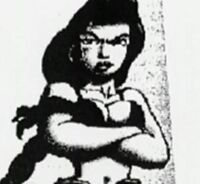
Concept of Laura Cruz.
Eidos direction preferred a more "UK friendly" name, and selected Lara Croft from similar-sounding English names they had found in a phone directory.[9] With the name changed, the character's story was also changed to a British origin.
One concern of Gard was to animate the character realistically, an aspect he felt to have been sidelined by the industry in this time. He then sacrificed quick animations in favor of realistic movements, thinking that players appreciate the character more easily. In the first Tomb Raider, the model of the three-dimensional character of Lara Croft is made of around 230 polygons. Graphical limits at the time required the removal of the braid of the character model, and was added to the model for the following games. While in the process of adjusting the model, Gard accidentally increased the size of the character's breast of 150%. After seeing the increase, the rest of the team had a debate over whether to keep the change or not. Core Design, employed Shelley Blond to dubbing Lara Croft after the game entered the beta phase of development. Gard left Core Design after completing Tomb Raider, citing a lack of creative freedom and control omnipresent of marketing on the ideas he developed (especially Lara Croft).
Core Design improved and modified the character in each episode. The developers of Tomb Raider II increased the number of polygons in the character model and added more realistic curves to its appearance. Other changes included new outfits and operations. Core Design had planned to allow the character to crawl as a new option, but the idea had not led until the installment of Tomb Raider III. Actress Judith Gibbins took over the responsibility of dubbing and remained until Tomb Raider III. In the third game, developers have again increased the number of polygons in the 3D model of Lara Croft to 300, and introduced more possibilities in gameplay. For Tomb Raider: The Last Revelation, the developers wanted to reintroduce the character to players and placed a passage with a much younger Lara Croft. Core Design improved character movement to allow more interaction with the environment, like walking on ropes and kicking open doors. The character model was altered to more realistic proportions, and Jonell Elliott gave back the job of Lara's voice to Gibbins. During early development, the team felt that Core Design had used all of his creativity. Feeling the series lacking in innovations, Core Design decided to kill the character, and made Lara Croft trapped in a sinkhole in the final scene of the game.

Design of Lara in The Angel of Darkness
The next installment, Tomb Raider: Chronicles , describes the past of Lara Croft through flashbacks of her friends. The game introduced sneak attacks, which have led to the next game, Tomb Raider: The Angel of Darkness.While the original development team working on the fifth installment, Core Design attributed to a new team the development of The Angel of Darkness for PlayStation 2. Anticipating of innovative changes from next generation consoles, Adrian Smith, co-founder of Core Design, wanted to reinvent the character to keep the rhythm with technology constantly being improved. Core Design conducted market research, including fan polls, to help the development of The Angel of Darkness. The development team had felt they could not alter the character and decided instead to opt for a situation differing from previous games. PlayStation 2 allowed more maneuvers and a more detailed character model, the number of polygons in the model of Lara up to 4400. The team tried to add more fights with bare hands to introduce Lara Croft as a peerless warrior as in her biography. The motion control went to a directional pad to a control analog stick, to improve the precision. After the original team finished Tomb Raider: Chronicles, they joined the development of The Angel of Darkness. Excessive content, exceeding the transit period, and the desire to Eidos to coincide with the release of the game with the Tomb Raider movie in 2003, did result of a poorly designed game, Lara Croft was brought back to life without explanation and with a lack of accuracy to control the character.
Crystal Dynamics[]
The Angel of Darkness is poorly received by critics, prompting Eidos - fearing of financial troubles from another unsuccessful game - they give the development of future titles to Crystal Dynamics.[10] The development team of the Legacy of Kain series began working on a new title, Tomb Raider: Legend, and Toby Gard agrees to cooperate as a consultant.[11] The team reconsidered the brand value of the franchise as well as the protagonist. Chip Blundell, vice president of brand Eidos, said that the designers understood that fans saw the character and brand as their own, rather than belong to Eidos.[10] With this priority, the team then reorganized the franchise and the character, in order to focus on the aspects of the original game.[10] [12] The story of a trilogy, starting with The Angel of Darkness was abandoned and a new plot was created for Legend.[10]
Crystal Dynamics focused on the credibility rather than realism to redevelop the character, giving decisions on the question "What could Lara do? "And offering more freedom for her actions.[13] The team has improved the movements of Lara Croft, making them more fluid and in continuity. The animations has also been upgraded, so that the character could better interact with environmental objects.[12] The developers introduced a feature that changes the clothes and skin of the character, making them wet after swimming and dirty after a roll on the ground.[12] [14] Responding to criticisms directed towards the control of the character in The Angel of Darkness, Crystal Dynamics changed control of the "skeleton" of Lara Croft to make the best experience of a third-person shooter game.[10] The developers have also introduced maneuvers of Close Quarter Combat.[15] Crystal Dynamics updated the character model to add more realism, but retained his caricatured design.[12][14] The account of polygons jumped to more than 9800, and more attention has been put in place to lip sync the character, as well as facial expressions, to enable dynamic responses to in-game events.[12] During the redesign of the character's appearance, Crystal Dynamics has improved hairstyles, wardrobe and accessories of Lara Croft. Her top was replaced by a V T-shirt, and her body became more muscular, her braid was shelved in favor of a ponytail.
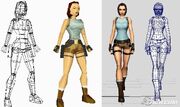
Differences between Lara's 1st Tomb Raider and Lara's Anniversary
Crystal Dynamics retained the changes in Legend, for the game Tomb Raider: Anniversary, a remake of the first game, the company has made some minor changes (such as the details of the model character). During the renewal of the original game, the designers aimed to represent deeper emotions. Crystal Dynamics focused on the character's desire to achieve her personal aim, reaching the climax where she must kill one of the antagonists. The team used this death to show the guilt of Lara Croft after the murder, and to show that killing a person is a difficult choice.
Tomb Raider: Underworld follows the plot started in Legend. Crystal Dynamics used new technology to improve the character for the seventh generation console, which allows for more realistic graphics. The accumulation of dust and wet clothing has been altered to be in real time and change in the environment of the whole game.[16] To display a more natural appearance, the developers added spherical harmonics to provide indirect lighting in game objects like Lara Croft. [16] The character model was more complex and detailed than previous ones, and used a skeletal animation to portray believable movement. The developers have also improved the facial model of Lara Croft by increasing the number of polygons, bones used in the animation skeleton, and graphical shaders in the face to add more details and capacities of expression. For adding to the realism, the hair has been created from a simulation of a real-time material, but they are pulled back, so they do not fly around Lara Croft during dangerous maneuvers. The body size was increased and the character's chest has been reduced for more realistic proportions.

Design of Lara in Underworld who can now aim two targets
The developers tried to redefine Lara Croft's actions by asking what would be the character abilities according to them. While previous games used the movements of animated characters by hand, Underworld introduced an animation based on motion capture for a more fluid, realistic movement and facial expressions.[16]The stuntwoman and Olympic gold medalist Heidi Moneymaker was the actress of motion capture, and advised the designers on the movements. Animators have adjusted and merged recorded animations, to create uniform transitions between separate movements and simultaneous combinations. Mergers and additional animations gave the character more flexible movement. Actions were nested to allow multitasking, like shooting on two separate targets with one hand while the other holds an object in the environment. Other additions were included for close combat attacks as contextual and climbing maneuvers. Crystal Dynamics wanted to ensure that the visual appearance of the character remains the same for the Xbox 360 to the PlayStation 3, although the systems uses different techniques. In response to Underworld's lackluster sales figures, Eidos reportedly considered altering the character's appearance to appeal more to female fans.[17]
Square Enix[]
Japanese game company Square Enix acquired Eidos in April 2009, restructuring Eidos into Square Enix Europe.[18][19] Crystal Dynamics remained the developer of the Tomb Raider games.[20] Lara Croft and the Guardian of Light introduced co-operative gameplay to the series, a move that brand director Karl Stewart said was meant to "show [Lara] as a more humanistic character" by placing her in a situation that differed from previous installments. The game uses the same technology featured in the studio's past Tomb Raider games.[21] Despite the changes implemented in the titles, Crystal Dynamics believed that the series required further reinvention to stay relevant.[22][23]
In late 2010, Square Enix announced a franchise reboot titled Tomb Raider; the new Lara Croft would be a darker, grittier reimagining of the character.[23][24] In examining the character, Crystal Dynamics concluded that Croft's largest failing was her "Teflon coating", and that it needed a more human version that players would care about.[23] The studio sought a new voice actress, trialling dozens of relatively unknown performers.[25] The second reboot focuses on the origin of the character, and as a result, changes the previous back story. Staff opted to first work on the character's biography rather than cosmetic aspects. Crystal Dynamics sought to avoid the embellished physique of past renditions and pushed for realistic proportions. In redesigning the character's appearance, the designers began with simple concepts and added features that it felt made Lara Croft iconic: a ponytail, "M-shaped" lips, and the spatial relationship between her eyes, mouth, and nose. The company also changed the character's wardrobe, focusing on what it believed was more functional and practical. In designing the outfits, staff aimed to create a look that was "relevant" and "youthful", but not too "trendy" or "hip". To gauge the redesign, Crystal Dynamics conducted eye tracking studies on subjects who viewed the new version and previous ones.[23]
Similar to Underworld, the new Tomb Raider features motion capture-based animation. In an effort to present realism and emotion in the character, Crystal Dynamics captured face and voice performances to accompany the body performances. The company plans to revamp Croft's in-game combat abilities. Crystal Dynamics aims to make the "combat fresh to the franchise, competitive amongst [similar games], and relevant to the story." Among the changes is the implementation of a free aiming system. The studio reasoned that such a system would cause players to be more invested in the action by fostering a "raw, brutal, and desperate" style. Global brand director Karl Stewart stated that such desperation relates to the updated character's inexperience with violence. He further commented that Lara Croft is thrust into a situation where she is forced to kill, which will be a traumatic and defining moment for her.[23]
Cultural Impact[]
Lara Croft's 1996 debut is often cited as a catalyst for more female leads in video games.[26][27] Kaiser Hwang of PlayStation Magazine commented that she "brought girl power" to video games. IGN argued that Croft helped redefine gender in video games by providing a different interpretation of what women could do.[28] Several publications have used her as the standard to which later female video game characters have been compared.[29][30][31] Video game publications like PlayStation Magazine, IGN, Edge, and PlayStation: The Official Magazine have labelled the character a video game and cultural icon.[32][33] Jeremy Smith credits Croft with exposing the Tomb Raider games and video games in general to a wider audience. Computer and Video Games commented that Croft's appearance on the cover of The Face signalled a change in the perception of video games from "geeky" to mainstream.[3] The character is honoured in the British city Derby, previous home to Core Design. In 2007, Radleigh Homes placed a blue plaque for Croft at the site of Core Design's former offices, now a block of flats.[34] The Derby City Council opened a public vote in 2009 to name its new ring road. The winning choice, with 89% of over 27,000 votes, was "Lara Croft Way", and opened in July 2010.[35][36][37]
Yahoo! Movies and IGN credit Jolie's role in the first Tomb Raider film with significantly raising her profile and propelling her to international super-stardom, respectively.[38][39] Jolie commented that young children would ask her to sign objects as Lara Croft. After filming for the first movie at the Cambodian temple Ta Prohm, the local inhabitants called it the "Angelina Jolie Temple" and local restaurants served Jolie's favorite alcoholic beverage advertised as "Tomb Raider cocktails".[40] IGN's Jesse Schedeen described Croft as one of few characters to receive a decent videogame-to-movie adaptation.[41] By 2008, the first Tomb Raider movie was the highest-grossing video game movie and the largest opening ever for a movie headlined by a woman.[42] It became the second highest-grossing video game movie in 2010, after the release of Prince of Persia: The Sands of Time.[43]
Reception[]
Gallery[]
|}
[]
| v - e - d
Characters of Tomb Raider |
|---|
| Main Characters Lara Croft (Movie Version) Jacqueline Natla • Amanda Evert • Winston Smith • Zip • Pierre Dupont • Doppelganger • Marco Bartoli Mark Willard • Sophia Leigh • Werner Von Croy • Larson Conway • Kurtis Trent • Pieter Van Eckhardt Shogo Takamoto • James Rutland • Joslin Reyes • Angus Grimaldi • James Whitman • Alex Weiss • Conrad Roth Samantha Nishimura • Jonah Maiava • Mathias Minor Characters Richard Croft • Amelia Croft • The Cowboy • Kid • Kold • Qualopec • Tihocan • Anaya Imanu • Toru Nishimura |
References[]
- ↑ Schedeen, Jesse (2008-11-17). The Many Looks of Lara Croft: Videogames. IGN.
- ↑ Staff (October 2007). "She's Had Work Done". PC Gamer (Future US) (166): 53.
- ↑ 3.0 3.1 Staff (2008). "Is Tomb Raider in Deep Water?". Computer and Video Games Presents (Future Publishing) (3): 20–29.
- ↑ Smith, Jonathan (December 1998). "Lara Swings Again". Arcade: The Videogame Magazine (Future Publishing) (1): 46–55.
- ↑ History of Tomb Raider. GameSpot (2000-10-31).
- ↑ Crystal Dynamics. Tomb Raider: Legend. (Eidos Interactive). PlayStation 2. (2006-04-07)
- ↑ McLaughlin, Rus (2008-02-29). IGN Presents: The History of Tomb Raider. IGN.
- ↑ Guinness World Records Gamer's Edition 2008, Guinness, 2008-03-11, 58–59 p. (ISBN 978-1-904994-21-3)
- ↑ Lauren Wainwright (November 4, 2011). The Redemption of Lara Croft.
- ↑ 10.0 10.1 10.2 10.3 10.4 David, Ziff (June 2005). "Hype - Tomb Raider: Legend". Official U.S. PlayStation Magazine Staff (93): 54–55.
- ↑ Rus McLaughlin (February 29, 2008). IGN Presents: The History of Tomb Raider.
- ↑ 12.0 12.1 12.2 12.3 12.4 "Tomb Raider Legend Preview". Game Informer (148): 87. August 2005.
- ↑ "Tomb Raider: Underworld Preview". PlayStation the Official Magazine (11): 48. October 2008.
- ↑ 14.0 14.1 "Tomb Raider Legend Preview". PlaStation Magazine (105): 44-45. 2005.
- ↑ Nelson (January 2008). "Tomb Raider 8 Preview". PlayStation the Official Magazine (3): 20-22[first=Randy.
- ↑ 16.0 16.1 16.2 "Tomb Raider Underworld Preview". Game Informer (183): 74-75. July 2008.
- ↑ Staff (March 2009). "Connect: Lara Croft's Makeover". Game Informer (GameStop) (191): 28.
- ↑ Magrino, Tom (2009-07-07). Square Enix retires Eidos publishing label. GameSpot.
- ↑ Staff (2009-07-07). Square Enix Europe formed. Computer and Video Games.
- ↑ Kato, Matthew (2010-03-04). Lara Croft's New Adventure. Game Informer.
- ↑ Cite error: Invalid
<ref>tag; no text was provided for refs namedEuro-Prev - ↑ Miller, Matt (2010-12-14). The History Of Crystal Dynamics. Game Informer.
- ↑ 23.0 23.1 23.2 23.3 23.4 Marie, Meagan (January 2011). "Tomb Raider". Game Informer (GameStop) (213): 42–51.
- ↑ Brown, Mark (2010-12-07). Tomb Raider reboot brings new Lara Croft. Wired News.
- ↑ Template:Cite podcast
- ↑ Staff (July 2003). "Breakthrough Games". PlayStation Magazine (US Imagine Publishing) (73): 50.
- ↑ Casamassina, Matt (2007-11-13). Tomb Raider: Anniversary Review. IGN.
- ↑ IGN PlayStation Team (2009-07-08). The Wednesday 10: Gaming Heroines. IGN.
- ↑ Staff (2001-06-15). "Girls got Game". The Beaumont Enterprise (Texas, United States). 0106230231.
- ↑ Staff. Girls of Gaming voting results. AskMen.com. IGN.
- ↑ Buffa, Chris (2009-01-23). Top 25 Game Archetypes: The smart and sexy heroine. GameDaily.
- ↑ Rayhill, Ryan (August 2007). "Tomb Raider: Anniversary". PlayStation Magazine (Future Publishing) (126): 82.
- ↑ Staff (December 1997). "Tomb Raider 2 Review". PlayStation Magazine (Future Publishing) (4): 29.
- ↑ Boyes, Emma (2007-04-24). Lara Croft 'birthplace' gets blue plaque. GameSpot.
- ↑ Staff (2010-02-26). "Derby inner ring road to be named Lara Croft Way". BBC News. http://news.bbc.co.uk/2/hi/uk_news/england/derbyshire/8538106.stm.
- ↑ Staff (2010-02-26). Derby road named after Tomb Raider star Lara Croft. The Daily Telegraph.
- ↑ Lara Croft Way opens in Derby. BBC (2010-07-27).
- ↑ McDaniel, Matt (2009-11-04). Angelina Jolie: An Action Star Worth Her 'Salt'. Yahoo! Movies.
- ↑ Parfitt, Orlando (2009-01-29). Top 10 Game-to-Film Posters. IGN.
- ↑ Shoard, Catherine (2010-11-25). Holy Jolie: Cambodian temple takes Angelina's name. The Guardian.
- ↑ Schedeen, Jesse (2009-04-24). Top 10 Most Overrated Videogame Characters. IGN.
- ↑ Staff (March 2008). "Reel Gaming: How Games are Invading the Big Screen, Again". Edge (Future Publishing) (186): 78.
- ↑ Ivan, Tom (2010-06-22). Prince Of Persia Becomes Highest Grossing Game Movie. Edge.


